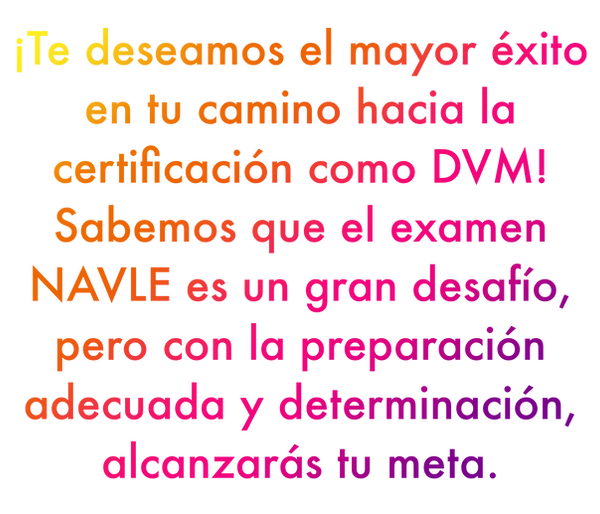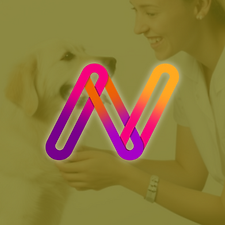
Preparación Completa para el Examen NAVLE
MVZ Esp. Paola Moreno Estañol
El North American Veterinary Licensing Examination (NAVLE) es un examen crucial que evalúa tus conocimientos y habilidades clínicas en medicina veterinaria, siendo un requisito indispensable para obtener tu licencia como DVM en Norteamérica. Aquí te proporcionamos una guía detallada con recomendaciones, estrategias y recursos que te ayudarán a prepararte de manera efectiva y enfrentar el examen con confianza.
¿Qué es el NAVLE?
El NAVLE consta de 360 preguntas de opción múltiple, divididas en 6 bloques de 60 preguntas, con un tiempo de 60 minutos por bloque. El examen se realiza en un formato computarizado, y los candidatos disponen de un total de 45 minutos de descanso que pueden tomar entre los bloques según lo necesiten.
Distribución del Contenido:
Un gran porcentaje de las preguntas del NAVLE se centra en:
-
Perros y gatos: Constituyen el enfoque principal del examen.
-
Caballos y bovinos: Representan el siguiente porcentaje más significativo.
-
Otras especies: Como aves, cerdos, animales exóticos y pequeños rumiantes, tienen una proporción menor pero aún importante.
Enfoca tu estudio principalmente en pequeños animales, seguido por grandes especies, sin olvidar repasar conceptos clave de especies menos comunes.
Recomendaciones de Estudio:
1. Fuentes de estudio esenciales:
-
Merck Veterinary Manual: Una herramienta gratuita y confiable para revisar conceptos clave y referencias rápidas.
-
VetPrep y Zuku Review: Plataformas diseñadas específicamente para el NAVLE, que incluyen simuladores, preguntas de práctica y análisis de desempeño.
-
Flashcards: Usa aplicaciones como Brainscape o Anki para repasar términos y conceptos clave.
-
Libros de texto:
-
"Small Animal Internal Medicine" de Nelson y Couto.
-
"Veterinary Medicine: A Textbook of the Diseases of Cattle, Horses, Sheep, Pigs, and Goats" de Radostits.
-
"Clinical Veterinary Microbiology" para enfermedades infecciosas.
-
2. ICVA Practice Exams:
Recomendamos utilizar los exámenes de práctica de la International Council for Veterinary Assessment (ICVA). Estos incluyen tres exámenes de prueba que te brindan una simulación real del NAVLE.
-
Costo: $_____ USD por cada examen.
-
Beneficios:
-
Familiarización con el formato y las preguntas del NAVLE.
-
Evaluación de tu preparación actual.
-
Identificación de áreas en las que necesitas mejorar.
-
-
Más información en la página oficial: ICVA Practice Exams.
Planificación del Estudio
¿Cuánto tiempo necesitas para prepararte?
Se recomienda comenzar a estudiar con 4 a 6 meses de anticipación. Dedica entre 2 y 4 horas diarias, dependiendo de tu ritmo de aprendizaje, y aumenta la intensidad a medida que se acerque la fecha del examen.
Estrategia de estudio:
-
Divide el contenido: Organiza tu tiempo para cubrir las áreas principales (perros, gatos, caballos y bovinos) antes de pasar a especies menos comunes.
-
Simuladores de exámenes: Realiza simulaciones de tiempo completo al menos una vez al mes para familiarizarte con el formato y gestionar la presión del tiempo.
-
Revisión diaria: Dedica tiempo cada día a repasar conceptos difíciles y practicar preguntas específicas.
-
Apoyo en grupo: Estudiar con colegas puede ayudarte a mantenerte motivado y compartir conocimientos útiles.

Recomendaciones para el Día del Examen:
1. Qué llevar:
-
Identificación válida: Asegúrate de que cumpla con los requisitos del centro de examen.
-
Snacks saludables: Frutas, nueces, barras de granola o cualquier alimento que te proporcione energía rápida.
-
Bebidas: Agua y café o té para mantenerte hidratado y alerta.
-
Medicación: Analgésicos como ibuprofeno en caso de dolores de cabeza o tensión.
-
Ropa cómoda: Usa ropa ligera y lleva una chaqueta o suéter en caso de que la sala esté fría.
2. Estrategias durante el examen:
-
Mantén la calma: Si te encuentras con una pregunta difícil, márcala y continúa. Puedes regresar a ella después.
-
Gestión del tiempo: Divide el tiempo de manera equitativa para completar todas las preguntas del bloque.
-
Usa tus descansos: Sal de la sala, estírate y respira profundamente para reducir el estrés.
Después del Examen:
1. Resultados:
-
Los resultados suelen estar disponibles 4 semanas después del cierre de la ventana de exámenes.
-
Recibirás una notificación por correo electrónico cuando estén listos.
2. Ventanas de examen:
-
Noviembre-Diciembre: Del 4 de noviembre al 21 de diciembre de 2024.
-
Abril: Del 1 al 26 de abril de 2025.
Manejo del Estrés:
-
Practica ejercicios de relajación: Técnicas como respiración profunda o meditación pueden ayudarte a mantenerte calmado antes y durante el examen.
-
Descansa adecuadamente: Duerme bien la noche anterior para estar alerta y concentrado.
-
Busca apoyo: Habla con colegas o mentores que hayan pasado por el NAVLE para obtener consejos y tranquilidad.


Comparte con tus colegas
NAVLE Test Prep
SHORT NOTES
Preparing for the North American Veterinary Licensing Examination (NAVLE) is a significant step in your journey to becoming a licensed DVM in North America. Our carefully curated Quick Notes are here to make your study process efficient, effective, and targeted.
What You'll Find in Our Quick Notes:
-
Comprehensive yet concise content: Key exam topics broken down into easy-to-digest summaries.
-
Essential insights: Focused on the most relevant areas, including dogs, cats, horses, cattle, and other species.
-
Exam tips: Proven strategies to manage time, tackle challenging questions, and maintain focus during the test.
Sections:

Porcine

Small Ruminants

Avian

Other Species
Comparte con tus colegas
Comprehensive Guide to NAVLE Preparation
Paola Moreno Estañol
The North American Veterinary Licensing Examination (NAVLE) is a critical step in obtaining your DVM license. This exam assesses your veterinary knowledge and clinical skills through a standardized format. Below is a detailed guide with recommendations, strategies, and resources to help you prepare effectively and face the exam with confidence.
What is the NAVLE?
The NAVLE consists of 360 multiple-choice questions, divided into 6 blocks of 60 questions each. You have 60 minutes per block to complete the questions. The exam is computer-based, and you are allotted a total of 45 minutes of break time, which you can take between blocks as needed.
Content Breakdown:
A significant portion of the NAVLE focuses on:
-
Dogs and cats: These represent the majority of the exam content.
-
Horses and cattle: The second-largest proportion.
-
Other species: Birds, pigs, exotic animals, and small ruminants make up a smaller but important portion.
Prioritize your study on small animals, followed by large animals, while ensuring you review key concepts for less common species.
Study Recommendations:
1. Essential Study Resources:
-
Merck Veterinary Manual: A free and reliable tool for reviewing key concepts and quick references.
-
VetPrep and Zuku Review: Comprehensive platforms tailored specifically for the NAVLE, offering practice questions, simulations, and performance analysis.
-
Flashcards: Use tools like Brainscape or Anki to reinforce terms and critical concepts.
-
Textbooks:
-
Small Animal Internal Medicine by Nelson and Couto.
-
Veterinary Medicine: A Textbook of the Diseases of Cattle, Horses, Sheep, Pigs, and Goats by Radostits.
-
Clinical Veterinary Microbiology for infectious diseases.
-
2. ICVA Practice Exams:
We highly recommend taking the ICVA Practice Exams to simulate the NAVLE experience. These exams provide valuable insight into your potential performance.
-
Cost: $_____ USD per exam.
-
Benefits:
-
Familiarity with the NAVLE format and question styles.
-
Evaluation of your current preparedness.
-
Identification of areas needing improvement.
-
-
Learn more: ICVA Practice Exams.
Study Planning:
How much time do you need to prepare?
Begin studying at least 4 to 6 months before the exam. Dedicate 2 to 4 hours daily, adjusting based on your learning pace, and increase intensity as the exam approaches.
Study Strategies:
-
Divide and conquer: Allocate time to cover major topics (dogs, cats, horses, and cattle) before reviewing less common species.
-
Simulated exams: Take full-length practice exams monthly to get used to the format and manage time pressure.
-
Daily review: Spend time each day revisiting challenging concepts and practicing specific questions.
-
Study groups: Collaborating with peers can help you stay motivated and exchange valuable knowledge.

Exam Day Recommendations:
1. What to bring:
-
Valid ID: Ensure it meets the testing center’s requirements.
-
Healthy snacks: Nuts, granola bars, or dried fruit for quick energy.
-
Drinks: Water and coffee or tea to stay hydrated and alert.
-
Medication: Pain relievers like ibuprofen in case of headaches or tension.
-
Comfortable clothing: Wear light layers and bring a jacket in case the room is cold.
2. During the exam:
-
Stay calm: If you encounter a difficult question, flag it and move on. Return to it later if time allows.
-
Time management: Divide your time evenly to ensure you complete all questions in the block.
-
Use breaks wisely: Step outside, stretch, and take deep breaths to recharge and stay focused.
Post-Exam Information:
1. Results:
-
Results are typically available 4 weeks after the exam window closes.
-
You’ll receive an email notification when your scores are ready.
2. Exam Windows:
-
November-December: November 4 to December 21, 2024.
-
April: April 1 to April 26, 2025.
Managing Stress:
-
Practice relaxation techniques: Deep breathing or meditation can help you stay calm before and during the exam.
-
Get adequate rest: Ensure you sleep well the night before to stay alert and focused.
-
Seek support: Talk to colleagues or mentors who have taken the NAVLE for tips and reassurance.




